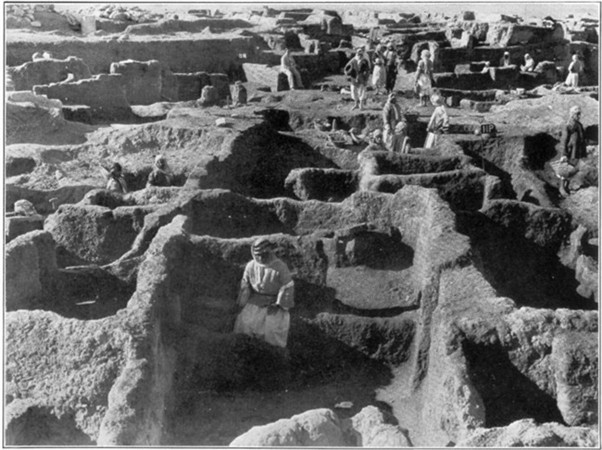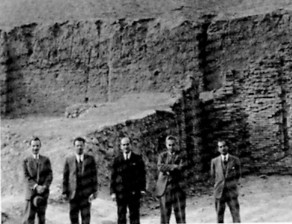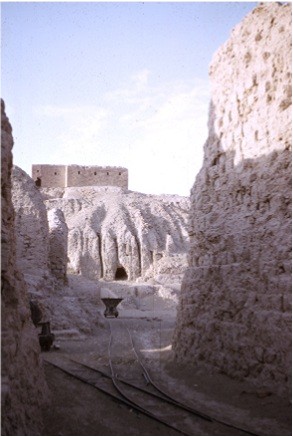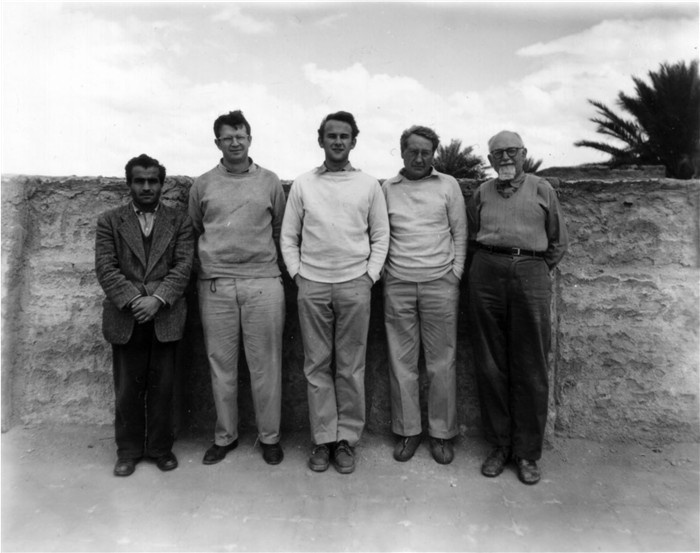A History of the Baghdad School of ASOR 1923-1969
The Founding of the School The origins of the Baghdad School of the American Schools of Oriental Research go back to the early years of the 20th century. In 1913, largely at the instigation of George A. Barton, the Archaeological Institute of America appointed a committee for the purpose of establishing a school of archaeology in Mesopotamia. The Committee included George A. Barton (Chair), Albert T. Clay, Morris Jastrow, Jr., James A. Montgomery, Edward T. Newell, James B. Nies and, apparently, William Hayes Ward. Just after World War I Clay traveled to Baghdad to lay the groundwork for the school. In 1921 the AIA's Committee affiliated itself with the American School of Oriental Research in Jerusalem, formally incorporating as the American Schools of Oriental Research in June. The Committee asked the AIA to be discharged at the end of that year since the establishment of a School had been assumed by ASOR which would also "represent the interests of the Institute in Archaeological matters in Mesopotamia as well as in Palestine..." |
|
From its beginning the Baghdad School was envisioned as an offshoot of the School in Jerusalem, with an Professor to be named each year traveling with students during the winter months from Jerusalem to Baghdad to pursue research. The Baghdad School's Director was to be based in the US, where he could oversee general policy and provide continuity. George A. Barton became the School's first Director, serving until 1934; Albert T. Clay its first Annual Professor (1923-24). On his death June 18, 1922, James B. Nies left substantial bequests to the American Schools including the residual portion of his estate to be held in trust for the Baghdad School's excavations and publications. Though the bequest was to go to the Schools only on the death of his surviving brothers, it nevertheless provided the Baghdad School with a modest financial underpinning (the Nies bequest became available to the School in the 1940s). |
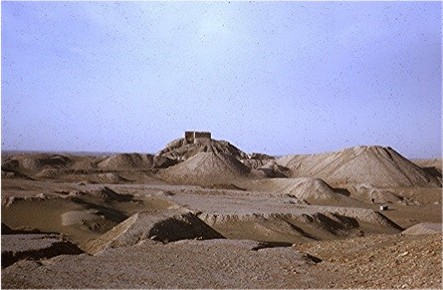 Nippur, 1967 see "The Post-WWII Era" below (click on all photos on this page for larger versions) |
Gertrude Bell, Iraq's Honorary Director of Antiquities, provided a preview of the evening in a letter dated October 31, 1923:
Mr. F. B. Riley, affiliated with Iraq's Ministry of Education, who was in also in the audience at the opening, gave a more sober assessment of the longer-term significance of the School's establishment.
|
|
The Baghdad School was initially housed in the US Consulate in Baghdad. When that arrangement proved impractical, Gertrude Bell offered space in the new National Museum. The Annual Professor in 1925-26, Raymond Dougherty, moved the School's library to the Museum before he left Baghdad in April, 1926 and it remained there, stored in increasingly crowded conditions--at one time sharing office space with the Museum's Director--until the late 1930s, when the School concluded arrangements with the Department of Antiquities to house the library in adequate conditions in the Museum and put it under the supervision of a librarian, making it available to "qualified users." The Baghdad School Library, built initially with bequests and donations from various individuals, including Morris Jastrow, who died in June, 1921,* was one of the first research libraries in Iraq and today constitutes the core of an enlarged Iraq Museum Library. |
 The Baghdad Museum, 1926 image from BASOR 22, "Reports from Prof. Dougherty; His Explorations in Iraq; The School to be Housed in the new Baghdad Museum" |
Iraqi officials repeatedly offered the Baghdad School a site for a permanent headquarters in the capital city (see, for example, Report of the Director of the School in Baghdad, BASOR 12, December 1923 or Notes from Professor Dougherty at Baghdad, BASOR 21, February 1926) and the School made various attempts, sometimes joining with other American institutions, e.g., the University of Chicago, to establish a physical presence in the country. Unfortunately, the School never really had the funds to secure its own building in Baghdad and its Annual Professors and Fellows had to make their own living arrangements in the city, often staying at the British School of Archaeology, founded in 1932 as a memorial to Gertrude Bell. |
|
Early Excavations and Research Edward Chiera followed Clay as Annual Professor in 1924-25. Chiera planned a survey of the southern part of the country, but Gertrude Bell's invitation to undertake excavations at Yorghan Tepe (Nuzi), a site near Kirkuk, from which antiquities were reaching Baghdad's markets, led him to change the locus of his activities. Chiera began excavations in early March, 1925, initially for the Iraq Museum, but in April continued his work as a joint excavation of the Iraq Museum and American School. Chiera, excavating on a small mound some three hundred meters north of Yorghan Tepe, where a local named Atiyah had reportedly had found twelve donkey-loads of tablets, uncovered substantial private houses and more then five hundred tablets. As might be expected, Gertrude Bell took notice of Chiera's work in a letter dated April 22, 1925: |
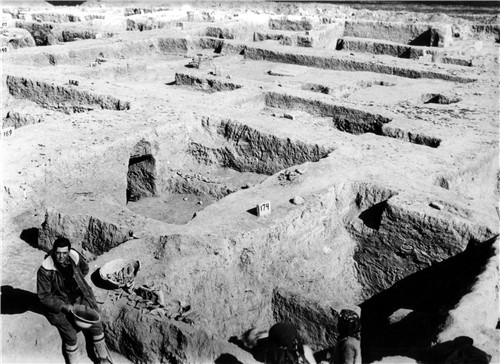 Annual Professor Pfeiffer at Nuzi, 1928-29 (photo courtesy of the Semitic Museum of Harvard University) |
|
|
Chiera's work was a particularly auspicious beginning to an active phase in the American School's history. The School continued the excavations at Yorghan Tepe in concert with Harvard University in 1927-28, 1928-29, 1929-30 and 1930-31. Prior to World War II the School was also involved in surveys, such as those undertaken of the southern floodplain by Raymond Dougherty, Annual Professor in 1925-26, and of the north by E. A. Speiser, Annual Professor in 1926-27, as well as excavations with the University of Pennsylvania at Tepe Gawra (1927, 1931, 1931-32, 1932-33, 1934-35, 1935-36, 1936-37 and 1937-38) and Tell Billa (1930-31, 1931-32, 1932-33, 1936-37),and Khafajah (1937-38). The School also supported Leroy Waterman as Annual Professor in 1927-28, affording him the opportunity to begin a series of excavations at Tell Umar, ancient Seleucia, and collaborated with the University of Pennsylvania in its 1931 excavations at Fara. After serving as an Annual Professor, E. A. "Fred" Speiser became Director of the School in 1934 and was to prove a very capable administrator during the difficult time that followed. |
|
The Post-WWII Era World War II brought the School's work in Iraq to a halt, and E. A. Speiser, Chairman of the Baghdad School, wryly noted in his report for 1941, "in the course of the past season fieldwork in Mesopotamia was under the direction of generals rather than archaeologists." Nelson Glueck, ASOR's Director in Jerusalem, who carried on with his surveys in Transjordan during the war, represented the School in communications with the Department of Antiquities in Baghdad. Glueck had been the Baghdad School's Annual Professor in 1933-34, when foreign excavators temporarily halted work in Iraq pending changes in the country's antiquities laws. |
|
Shortly after the War came to an end, the Baghdad School resumed its activities. Samuel Noah Kramer was named Annual Professor in 1946-47 and was able to work in museums in Istanbul and Baghdad. In 1946 the School established the Journal of Cuneiform Studies, with an Editorial Board consisting of Albrecht Goetze, Thorkild Jacobsen and Abraham Sachs. In 1947 Goetze became Director of the Baghdad School, serving for ten years and playing a prominent role in the Baghdad School until his death in 1971. In the 1950s and 1960s, the Baghdad School once again played a highly visible role in supporting field work in Iraq. It supported Robert J. Braidwood's Prehistoric Project, naming Bruce Howe as Fellow in 1950-51 and Annual Professor in 1954-55, 1959-60 and 1963-64. |
|
The School supported the early post-WW II seasons at Nippur, appointing field epigrapher Francis Steele its Annual Professor in 1949-50 and 1951-52. When the University of Pennsylvania withdrew from the Nippur excavations after the 1950-51 season, the Baghdad School joined the Oriental Institute in sponsoring the excavations. The principal focus of work during the years that ASOR co-sponsored the Nippur excavations was the temple of Inanna, whose Early Dynastic levels yielded unique architecture and rich inventories of sculpture. Thorkild Jacobsen, Nippur's epigrapher, was Annual Professor in 1953-54 and Goetze, the epigrapher in the 5th (1955-56) and 6th (1957-58) season, was Annual Professor in the former year. Richard C. Haines, who directed the excavations, was Annual Professor in 1960-61 and, Donald P. Hansen, field archaeologist, in 1962-63. Hansen began excavations at Tell Abu Salabikh, where he made the important discovery of late Early Dynastic texts, published by Robert D. Biggs, shortly after the end of the 1962-63 field season at Nippur. The Baghdad School also supported Hansen's later excavations at al-Hiba (Lagash), a project he initiated in 1968 with Vaughn Crawford, who headed the School following Goetze. In addition to its excavations, the Baghdad School played a prominent role in innovative archaeological surface surveys conducted by Thorkild Jacobsen, Vaughn Crawford and Robert McC. Adams. The School jointly sponsored Adams' 1956-57 Iraq Surface Survey of the Akkad region. Adams was the Annual Professor for 1966-67, and then Resident Director of the Baghdad School in 1968-69, when he used the Oriental Institute's house at Nippur as a base for his survey of the area, as well as excavations at Tell Abu Sarifa, a project that aimed to disentangle Sassanian and early Islamic ceramic chronology. |
|
Following the 1967 Arab-Israeli War and the July 17, 1968 revolution that brought the Arab Baath Socialist Party to power, the situation for foreign archaeologists in Iraq deteriorated. McGuire Gibson, the School's Annual Professor for 1969-70, reached Baghdad, but was not given permission to work. Following the handwriting on the wall, the Baghdad School Committee, which had existed since 1921, changed its name to the Committee on Mesopotamian Civilization in December 1969 and made the Annual Professorship into a Fellowship for "study of Mesopotamian civilization--be it philology, archaeology, or art history -- in Lebanon, Syria, Turkey, Iraq, Iran, or any other country where the pertinent materials are available" (Board of Trustees minutes, Dec. 29, 1969). The first recipients of the Mesopotamian Fellowship were Stephen Lieberman (1970-71), Elizabeth Carter (1971-72), and Norman Yoffee (1972-73); the most recent Jennifer Pournelle (2001-02), Sarah Graff (2002-03) and Bekir Gürdil (2003-04). In addition to awarding the Mesopotamian Fellowship, the Committee on Mesopotamian Civilization has continued to publish and support the Journal of Cuneiform Studies. Upon Goetze's death in 1971, Erle Leichty became Editor and served for twenty years, contributing not only his time, but providing financial support as well. When he stepped down in 1991, William L. Moran, who had just retired from Harvard University, took over as Editor, and a new Editorial Board (Gary Beckman, Elizabeth Carter, Piotr Steinkeller and Matthew Stolper) began work. For various reasons, Moran gave up the position and Piotr Michalowski (University of Michigan) replaced him. The Committee began publishing a Directory of Mesopotamian Scholars beginning in 1985, a project John A. Brinkman, Annual Professor in 1968-69, continues today. The Committee also published a bi-yearly newsletter entitled Mar Sipri between 1988 and 1993. The Newsletter, edited by Paul Zimansky (Boston University), was devoted to current research in Iraq. In the late 1980s the Committee was able to resume its support for excavations in Iraq thanks in large part to a generous contribution from P.E. MacAllister, current Chairman of ASOR's Board of Trustees. These Baghdad Excavation Awards funded projects at the sites of Tell Hamide, Mashkan-Shapir (Tell Abu Duwari), Abu Salabikh, and Tell al-Deylam (Dilbat). * On his death in 1916, William Hayes Ward left his library to an American school of archaeology to be established in Mesopotamia, provided such a school were established within ten years of his death. After some litigation, the library came into the American School's possession in 1928. After cataloguing, the Director of the School attempted to fill in gaps in Ward's holdings, but whether Ward's library was ever shipped to Baghdad cannot be determined. Lists of Directors and Annual Professors of the Baghdad School are available below and a list of Mesopotamian Fellowship awardees is also posted.
|
|
Directors of the Baghdad School
George A. Barton
(1923-1934)
E. A. Speiser (1935-1946)
Albrecht Goetze (1947-1956)
Vaughn Crawford (1956-1968)
Robert McC. Adams Resident Director (1968-69)
Following Crawford's tenure, the Chairman of the Baghdad Committee, an advisory committee that had existed since the School's founding, became the de facto head of the Baghdad School/Committee on Mesopotamian Civilization.
Chairmen of the Baghdad Committee have included:
Samuel Noel Kramer (1955-1964)
Donald P. Hansen (1964-1970)
John A. Brinkman (1971-1985)
McGuire Gibson (1985-1986)
Jerrold Cooper (1987-1993)
Elizabeth Carter (1994-96)
Paul Zimansky (1997-2002)
Richard L. Zettler (2002- )
Annual Professors
Albert T. Clay (1923-24)
Edward Chiera (1924-25)
Raymond Dougherty (1925-26)
E. A. Speiser (1926-27)
Leory Waterman (1927-28)
Robert H. Pfeiffer (1928-29)
Henry F. Lutz (1929-30)
T. J. Meek (1930-31)
Nelson Glueck (1933-34)
Albert T. Olmstead (1936-37)
Elihu Grant (1937-38)
T. J. Meek (1938-39) Nominated
Samuel N. Kramer (1946-47)
Albrecht T. Goetze (1947-48)
George G. Cameron (1948-49)
Francis R. Steele (1949-50)
No Annual Professor (1950-51)
Francis R. Steele (1951-52)Alexander Heidel (1952-53)
Thorkild Jacobsen (1953-54)
Bruce Howe (1954-55)
Albrecht T. Goetze (1955-56)
Vaughn Crawford (1956-57)
Fred V. Winnett (1958-59)
Bruce Howe (1959-60)
Richard C. Haines (1960-61)
Stephen D. Simmons (1961-62)
Donald P. Hansen (1962-63)
Bruce Howe (1963-64)
T. H. Carter (1965-66)
Robert McC. Adams (1966-67)
Richard S. Ellis (1967-68)
John A. Brinkman (1968-69)
Thorkild Jacobsen (1968-69) Without stipend
McGuire Gibson (1969-70)
last updated 1/9/04
